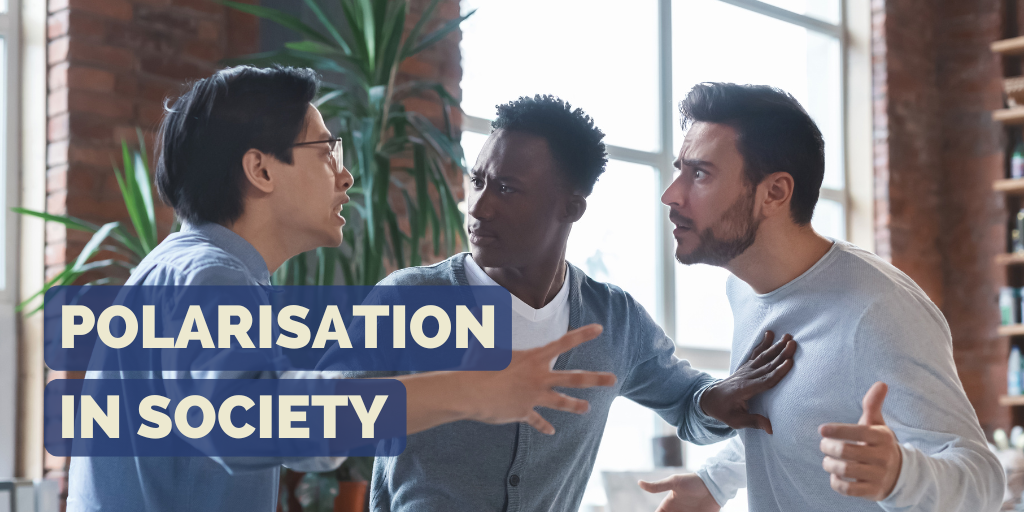What does polarisation mean for our society?
In current political and social debates, the tone seems to be becoming increasingly uncompromising. Opinions are unwavering and often leave little room for change. Yet our democracy thrives on compromise and understanding for the positions of others. Where does this increasing polarisation come from, what does it mean for our society and what can we do about it? We want to take a closer look at this in this article.
What is the definition of polarisation?
Polarisation is the strong divergence of opinions among different social groups or individuals on different topics or towards others. Strong polarisation means that positions differ widely and there is no mutual understanding. It can be divided into affective and ideological polarisation. The former describes a strong emotional connection to a topic as the cause of strong beliefs that are contrary to those of other groups. Ideological polarisation, on the other hand, describes an opinion based on (factual) convictions.
Who polarises & why?

To understand how polarisation works, it is helpful to ask yourself these questions:
- Who is polarised?
- Who creates polarisation?
Who is polarised?
In principle, any person or group can have a polarised opinion on a topic. A recent study by the Marcator Foundation and TU Dresden from 2023 examined how polarisation in Europe is distributed across different countries and social and political groups – a clear recommendation for anyone who wants to delve deeper into the topic.
The study shows that the stronger one’s own opinion on a topic is, the greater the potential polarisation, i.e. the more one distances oneself from dissenters. Polarisation can be strongly influenced by current discourses and media sentiments, like debates on immigration, the war in Ukraine or climate change show (more on this in the section “Which topics polarise?”). A particularly strong polarisation can be observed among AfD supporters on these issues.
However, at the same time, a high level of political interest and the will to shape the future also ensure high polarisation values, which can be observed particularly in progressive positions such as the Greens. They have a “scientocratic understanding of politics – in other words, the conviction that what science says must be translated directly into policy”, according to Hans Vorländer, head of the Marcator study.
It is therefore important to consider the various reasons for polarisation. Because of course “democrats can reject undemocratic things for very good reasons”, says Jochen Rose, social researcher at the Konrad Adenauer Foundation.
Who creates polarisation?

Polarisation usually stems from people or institutions that receive a certain amount of attention and therefore have the potential to influence public opinion. This includes:
- Media that convey a strong and sometimes deliberately one-sided (polarised) point of view in their reporting on certain topics. Well-known examples of particularly polarising media are BILD, the far-right Compact magazine and conspiracy blogs such as Tichys Einblick. In contrast, qualitative journalism (regardless of the political direction) focuses on presenting facts and different perspectives on a topic, including ambivalences and nuances.
- Politicians who, through their positions, rhetoric and actions, deliberately represent certain one-sided (polarised) views on issues that are conducive to their ideology and interests. Even though this can potentially apply to all politicians, there are some examples of extreme and deliberately polarising statements. For example, Friedrich Merz’s polarising statements on people with refugee backgrounds, historically revisionist right-wing extremist statements by Alice Weidel and Björn Höcke or Russia-friendly demands by Sarah Wagenknecht.
- Activists who take up extreme (polarised) positions to mobilize for certain issues. Examples include the Last Generation or campaigns by the animal welfare organization PETA.
Why is there polarisation?
The aim of polarisation is usually to generate attention through exaggerated representations.
- Activists usually use polarisation to draw attention to grievances.
- In the case of the media, polarisation is often used to increase sales and click rates, which rise more through scandals and sensational topics than through balanced reporting. In addition, there are also campaigns to create a specific feeling for or against an issue or person.
- In politics, issues or problems are often exaggerated in order to present oneself as a solution provider and at the same time create a “we-feeling” among voters. Opposing or differentiated positions are defamed and the opposition is portrayed as an enemy to be fought against. The goal is to secure the support of the electorate by emphasizing self-selected (often emotional) issues, thereby earning approval and ultimately winning elections.
How is polarisation achieved?

If we look a little more specifically at the question of how polarisation takes place, it is worth taking a look at the AfD’s methods as an example. Deutschlandfunk has compiled an analysis of the party’s communication strategy, in which experts see the most important reason for its success.
It is fundamentally based on four elements, which political and communications consultant Johannes Hillje described back in 2017 in his article “Propaganda 4.0 – the AfD’s strategy for success“:
- Delegitimization of the established jornalistic media outlets
- Development and establishment of own party-related media channels
- Formation of a collective identity or right-wing populist parallel society
- Extreme polarisation in public discourse
Delegitimization of the established journalistic media
Public broadcasting in particular is attacked by the AfD. These are denounced as fake media, state-controlled press, or state-run radio. According to a concept of the party from 2017, ARD and ZDF are to be dissolved and privatized. All of this serves to delegitimize independent reporting, as is also practiced in totalitarian states.
“The AfD demonizes the independent media as ‘system press’, but at the same time it needs them as a stage for its stagings, provocations and demarcations from the political enemy.” – Hillje
Development and establishment of own party-related media channels

Compared to other political parties, the AfD markets itself very successfully on social media and has now built up its own network. According to Hillje, public speeches of the AfD’s Members of Parliament are written in such a way that they are optimized for social media. The AfD now has almost 400,000 subscribers on YouTube, while political parties such as the SPD or the CDU/CSU only have 4,000-5,000 subscribers (more on the AfD’s social media strategy here).
Formation of a collective identity
“Us against them” is not only a popular scheme for the AfD. By agitating against others – be it “those at the top”, “the foreigners” or “the lazy recipients of citizens’ benefits” – the sense of togetherness is strengthened. “We” are always those who are on the right side and who, in case of doubt, reserve the right to enforce their “right” position by force. What is important here is not so much the thematic orientation of the “we group” – i.e. what they actually stand for – but rather the separation to the outside, which is always presented as a threat.
Extreme polarisation in public discourse
Simplified affirmative claims (i.e. those that are easy to agree with), fake news and the deliberate use of negative buzzwords are used to evoke strong emotions. The provoked anger and resentment is specifically directed towards other parties or organizations that allegedly want to destroy Germany. This serves to enhance their own status as the “voice of the silent majority” and to delegitimize their political opponents.
Which topics are particularly polarising?

As indicated at the beginning, there are a number of topics that have the potential to have a polarising effect on social groups and individuals. These include:
- Climate change
- Immigration
- Russian war of aggression in Ukraine
- Pandemics like Covid-19
- Social benefits and their financing
- Equality of women in society
- Dealing with sexual minorities
According to the Mercator study, there is a strong polarisation across Europe, particularly when it comes to climate change and immigration.
- For example, despite the clear facts on climate change, there are still many people who do not see it as an urgent problem or percieve it as an invented scare tactic to promote certain interests. In addition, there are very opposing attitudes to the necessary changes and reasonable measures to combat climate change, which are causing polarisation on the issue.
- Since the so-called “refugee crisis” of 2015, immigration has also been a highly polarising topic, which has been fuelled in particular by far-right and right-wing populist movements and parties in Germany and Europe. The resulting tensions between progressive-liberal and conservative-restrictive positions appear to have a clear negative impact on the social community and political stability in Europe.
- Other issues such as equality for women or social benefits also have the potential for polarisation, but according to the study, this potential is much weaker.
For more information on the other polarising topics, we recommend taking a direct look at the study mentioned above.
How polarised is Germany?

The 2021 Mitte study by the Friedrich Ebert Foundation talks about attitudes that threaten democracy and their effects. It shows that hate campaigns and new right-wing and far-right developments in particular have posed a major challenge to the (democratic) centre of society in recent years.
At the same time, the Mercator study shows that, Germany tends to be positioned in the middle of the political divide in comparison to other European countries. This shows that people and opinion camps are less divided than media reports and political debates would have us believe. This is particularly evident in comparison to Italy and Greece, which are especially divided into irreconcilable political camps.

What are the consequences of polarisation?
Of course, we should not rest on the fact that other countries are more divided. In Germany, it is becoming clear how affective polarisation in particular is ensuring that political debates are increasingly characterized by outrage and the deliberate creation of sentiments against “the others”.
Even if different opinions are essential for a vibrant democracy, they become problematic if they are so strongly separated from one another that discussions become impossible. This can lead to the fundamental rejection of other opinions, which undermines the sense of community and ultimately the trust in institutions.
Get involved for an open society via vostel.de
In order to counteract the polarisation in society, countless organisations in Germany are committed to further open discourse and diversity. You can now support many of them by getting involved via vostel.de and thus contribute to a less polarised society that works together towards a better future.
Your team from vostel.de
wishes you much success with your commitment against polarisation in Germany!









No Comments yet!